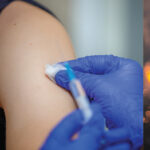The Impact of Chronic Underfunding on America’s Public Health System: Trends, Risks, and Recommendations, 2020
This report, a part of TFAH’s annual public health funding series, found a continuing pattern of underfunding of these vital programs.
Health emergencies—from flooding to wildfires, vaping-associated lung injuries to the novel coronavirus (COVID-19)—are a stark reminder of the critical importance of public health and emergency preparedness programs.
The nation needs to prepare for increasing public health challenges.
Our nation’s public health challenges are on the rise. We face the ongoing challenges of the seasonal flu, vaccine-preventable disease outbreaks, the growing number of Americans who have obesity, risks associated with vaping, rising rates of sexually transmitted infections, and the opioid and other substances misuse and suicide epidemics. Weather-related emergencies are now more frequent and more intense due to the effects of climate change. In addition, as TFAH was producing this report, the world was grappling with the unprecedented threats of the COVID-19 pandemic, a crisis that is illuminating these risks in ways Americans had never imagined.
While the United States spends an estimated $3.6 trillion annually on health, less than 3 percent of that spending is directed toward public health and prevention. Furthermore, public health spending as a proportion of total health spending has been decreasing since 2000 and falling in inflation-adjusted terms since the Great Recession. Health departments across the country are battling 21st-century health threats with 20th century resources. The COVID-19 crisis demonstrates this reality in the starkest of terms.
Fiscal year 2020 public health funding is a mixed picture
The U.S. Centers for Disease Control and Prevention (CDC) is the primary driver of federal public health funding through its grant programs to the states and large cities. CDC’s overall budget was up by 9 percent between FY 2019 and FY 2020, or 7 percent when adjusted for inflation. FY 2020 increases were due to onetime funding for buildings and facilities, for some new initiatives like public health data modernization and ending HIV, and to replace expiring global health security funds with annual funds. Programs that had not received funding in many years, such as suicide prevention and gun violence research, received modest investments. Even with these increases,
CDC’s program level budget remains just above its level in FY 2008, when adjusting for inflation. And there remains a mismatch between need and funding levels
CDC’s program level budget remains just above its level in FY 2008, when adjusting for inflation And there remains a mismatch between need and funding levels —for example, the funding to fight obesity was held stagnant, leaving only enough funding for 16 states to combat one of the leading drivers of health costs.
The Prevention and Public Health Fund, which was designed to expand and sustain the nation’s investment in public health and prevention, remains at half of where it should have been funded in 2020 due to the reappropriation of monies to other spending programs.
Three other federal agencies with significant public health responsibilities, the Food and Drug Administration, the Substance Abuse and Mental Health Services Administration, and the Health Resources and Services Administration saw modest operating gains for FY 2020.
State investment in public health programs was also mixed. Most states (39) and the District of Columbia increased or maintained funding for public health budgets in FY 2019, but 11 states decreased such funding.
Funding for emergency preparedness programs has been repeatedly slashed
CDC funding for public health preparedness and response programs decreased between FY 2019 and FY 2020, from $858 million to $850 million and has been cut in half over the last decade.
The Hospital Preparedness Program—part of the Office of the Assistant Secretary for Preparedness and Response in the U.S. Department of Health and Human Services—is the single source of federal funding to help regional healthcare systems prepare for emergencies. Its budget was $515 million in FY 2004 and $275.5 million in FY 2020.
The core capabilities of a robust public health system are vital
Keeping Americans safe from disease, disaster, and bioterrorism requires a public health system that is focused on prevention, preparedness, and surveillance. Investment to ensure foundational capabilities is key. Interagency and jurisdictional planning and cooperation are also critical, as is paying attention to the needs of population groups or communities at the greatest risk of harm during emergencies. All of these activities require dedicated and sustained funding.
Also critical to protecting the public’s health is a well-trained and appropriately resourced public health workforce. Over the past decade, the public health workforce has shrunk by approximately 56,000 positions primarily due to funding issues. The Public Health Workforce Interests and Needs Survey found that a large proportion of workers are considering leaving their organization in the next year, in part due to inadequate pay. Also of concern, state health officials estimate that 25 percent of their workforce will be eligible for retirement in 2020.
An unfortunate pattern has emerged: as a nation, we pay attention to public health investment when there’s a crisis, often borrowing from existing public health budgets (money typically meant to address chronic illness) to pay for the emergency response before falling back into a pattern of underinvesting in public health. This robbing-from-Peter-to-pay-Paul approach has left the nation’s public health infrastructure on weak footing. The Public Health Leadership Forum estimates that an annual infusion of $4.5 billion is needed to fully support core public health foundational capabilities at the state, territory, local, and tribal levels nationwide.
The core capabilities of a robust public health system include:
|
Investments in public health improve health outcomes and reduce health spending
The United States spends trillions annually on healthcare, but Americans aren’t getting healthier. One reason is the lack of focus on prevention within our health systems. In 2018, public health spending amounted to approximately $286 per person—just 3 percent of all healthcare spending in the country. Investment in public health programs saves money by preventing injury and illness, which is particularly important as the population ages. Nearly half of all Americans age 55 and older have two or more chronic conditions, such as diabetes or hypertension.
Priorities for policy action
The report includes 28 recommendations for policy action within four priority areas:
- Increased funding to strengthen the public health infrastructure and workforce, including modernizing the system’s data and surveillance capacities.
- Safeguarding and improving Americans’ health by investing in chronic disease prevention and the prevention of substance misuse and suicide.
- Improving emergency preparedness, including preparation for weather-related events and infectious disease outbreaks.
- Addressing the social determinants of health and advancing health equity.
Read the full report |

